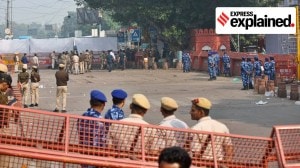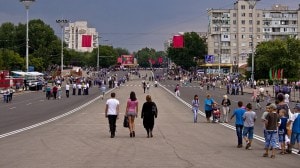ROJA— Dus Saal Baad
The film’s stupendous success turned its little-known lead actors — Arvind Swamy and Madhoo — into household names, establish...

A CHASE through the Kashmir woods. Gun-toting securitymen swarm through the cold, tangled darkness to corner their quarry. A few minutes later, a dangerous militant is arrested. Cut to: lush southern fields, plentiful grain, herds of goats, waterfalls, swaying palm trees and a young girl singing Dil hai chhota sa, chhoti si asha.
It has been 10 years since this memorable opening sequence of the Tamil film Roja hit the silver screen. Winning three national awards, six state awards, dubbed into as many as five Indian languages, it went on to run for 18 months in 22 states, becoming something of a national rage.
The first thing that most people recall at the mention of Roja is the music. In retrospect, it is ironic that Rahman was not Ratnam’s first choice. The Bombay Dreams composer, who was then in his 20s, was reportedly paid a modest Rs 25,000 and claimed that ‘‘good lyrics’’ and an ‘‘international’’ touch were responsible for the success of the soundtrack.
| Govind Nihalani was among the first to take his cues from Roja. In Drohkaal, Ashish Vidyarthi played a terrorist |
| Like Drohkaal, Gulzar’s Maachis was set in Punjab, and explored the psyche of youths taking up the gun |
| Mission Kashmir and Fiza, both starring Hrithik Roshan, traced the making of a terrorist sympathetically |
| Seven years after Roja, John Mathew Mathan broke new ground in Sarfarosh by naming Pakistan’s ISI |
| By the time Gadar came along in 2001, the patriotism of Roja had given way to jingoistic overtones |
| The spate of Bhagat Singh biopics has carried forward the chest-thumping brand of patriotism |
The popular score, however, was just one of many elements that went into this unusual project. There was the plot — a wafer-thin story of a software engineer travelling to Kashmir on a mission for the army accompanied by his young bride. Kidnapped by militants who demand the release of their jailed colleague in lieu of his life, Swamy, who plays the engineer, holds pointed discussions with his captors about their beliefs while his child-wife runs from pillar to post to save her husband. It is, at one level, a simple love story, the myth of Savitri seeking the restoration of her Satyavan. But the ideological conflict between a nationalistic victim and jehadi militants is a significant backdrop and a deliberately chosen one.
It was, at the time, a startling subject to pick. Commercial cinema had moved from the smuggler-builder villain of the ’70s to larger-than-life madmen (Mogambo, Dr Dang) who dreamt of ‘‘buying India’’ and widescale destruction. With Roja, Ratnam made the villain real and that much more terrifying. By the standards of commercial cinema, Roja portrayed a stark portrait of Kashmir as a perennially curfew-hit land, bristling with armed securitymen and silent, deadly militants. It also painted the villain in shades of grey, rather than black, allowing him motivations that were not necessarily dishonourable. When the hero asks his kidnappers what they want for example, the reply is azaadi. As filmmaker Govind Nihalani points out, ‘‘The villain in Roja is not out to sell drugs or steal. He is given a political ideology.’’
It was the first of an emerging trend. Nihalani himself went on to make Drohkaal, with Ashish Vidyarthi turning in a provocative performance as a terrorist chief. The film was set in Punjab, like Gulzar’s Maachis, which followed the trajectory of young boys turning to militancy. Both films, along with Vinod Chopra’s Mission Kashmir and, to some extent, Khalid Mohamed’s Fiza, offered a measure of debate on the issue of terrorism. In Drohkaal, for instance, the captured militant asks, ‘‘Do you ever ask what forces us to pull a gun? The state uses force to keep itself in power.’’ In Mission Kashmir, a small boy witnesses his entire family being wiped out in an army operation and grows up to take arms against the state. But while these films made some attempt to penetrate the psyche of the terrorist, there was another far more prescient strain in Roja.
‘‘I think Roja brought back patriotism,’’ claims Screen editor Bhawna Somaya. Early on in the film, as she points out, the young bride chides her husband for calling her village small and undeveloped. That scene raises a metaphor that the director picks up later when the kidnapped hero stands up for his country. In one scene he is slapped and beaten for repeatedly saying ‘‘Jai Hind’’. In another, a scene that has become almost iconic through frequent repetition, he courts death by rolling over a burning Indian flag in an attempt to put out the fire even as Rahman’s score swells in the background.
Many have accused Ratnam of soft peddling serious issues by romanticising them; (in Roja, as a leading director scathingly points out, Kashmiris wear Himachali caps) and in this, as in Ratnam’s other films (Dil Se, Bombay), the love angle dominates. But even the few scenes of nationalistic pride in Roja were enough to imbue the film with a thick hue of patriotism. In fact, a substantial part of the film’s appeal was the manner in which it tapped into a latent public consciousness. If anger had been building up through the ’80s against the growing incidence of terrorism in the country combined with suspicions of a Pakistani hand, then Roja and, later, Sarfarosh, which named Pakistan’s ISI as a saboteur, were, as Nihalani claims, ‘‘a great catharsis for both the filmmakers and the audience’’.
There was nothing complex or ambiguous about this concept of country love. Roja is notable for the complete absence of ordinary Kashmiris and their views on the Indian state. But Ratnam effectively provided the creative cues for this new wave patriotism. The tricolour, rousing music, simplistic emotions and lyrical vistas have become staple treatment for commercials and television spots on patriotism and were much in evidence during the Kargil crisis. They have become an essential part of regular films as well. Even love stories and family dramas such as Kuch Kuch Hota Hai and Kabhi Khushi Kabhie Gham use the evocative power of national emblems. A more direct fallout has been the spate of films, many with jingoistic overtones on nationalistic subjects: The various Bhagat Singh biopics and the recent Sunny Deol-starrer Maa Tujhe Salaam, which had the hero fighting off invaders at the LOC.
Apart from the significance of its theme, the countrywide success of Roja marked the advent of another phenomenon, which was the invasion of Bollywood by talent from the south. The development was not entirely new. The south has always enjoyed a presence in the Mumbai film industry through its family dramas and individuals such as Kamal Haasan, who had a foot in both places. Yet at a time when nobody was willing to tackle a sensitive issue like terrorism on screen, it seemed a particularly bold step for a filmmaker from the South to throw his net as far north as Kashmir. With his typically middle-class South Indian hero, Ratnam, as the writer Anita Nair points out, contrasted ‘‘Kashmiri ‘extremists’ with a Tamil nationalism inflated to an all India patriotism.’’
It opened the floodgates. In the early ’90s, the Mumbai film industry — once a preserve of the enterprising northerner — was invaded by denizens of the south. Prabhudeva burnt up dance floors while Ram Gopal Varma created a sensation with Rangeela. Rehman and Santosh Sivan set the bar for quality in music and cinematography and there were others: Priyadarshan, who made Virasat, Rajiv Menon who directed Sapnay and Shanker, who created the wildly extravagant Jeans.
The effects of the invasion are still visible, whether it is in terms of a continued influx or in the introduction of a new style. ‘‘Mani Ratnam and Santosh Sivan’s use of imagery to move the narrative forward was a major shift from the pure narrative preferred earlier by the Hindi film industry,’’ claims Mumbai-based cinematographer Sanjay Kapoor. ‘‘Every second film these days is being shot by a cinematographer from the South.’’
Ram Gopal Varma, who believes, like Ratnam, in treading the fine balance between commercialism and art, is another southerner who has redefined style in Bollywood with his choice of themes and sophisticated treatment.
In Roja, the innocent southern belle befriends a fortune teller from the north in her search for her husband. The old dividing lines have been blurred. A decade later that is probably one of the film’s enduring contributions.
|
INTERVIEW KANDASWAMY BHARATAN, producer, Roja
Story continues below this ad Why the international release? You spent Rs 3 crore on the movie 10 years ago. How much has it made at the box-office? |





- 01
- 02
- 03
- 04
- 05


























